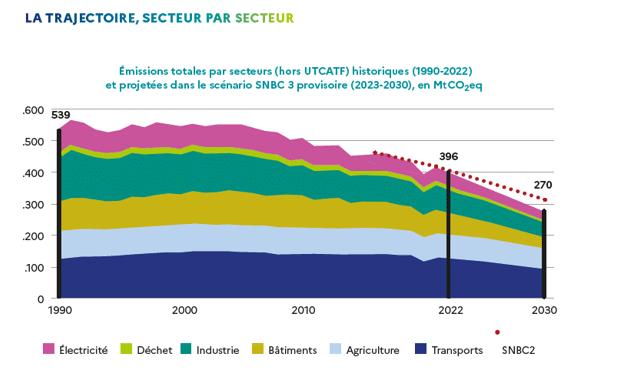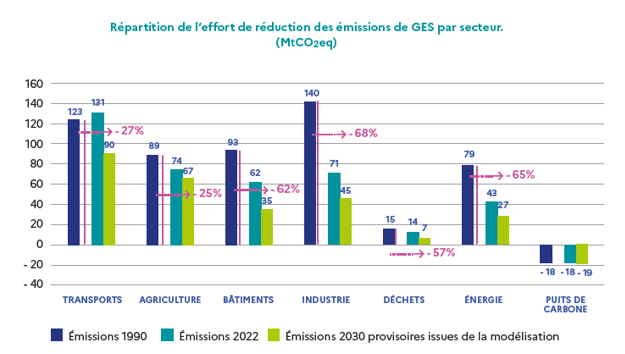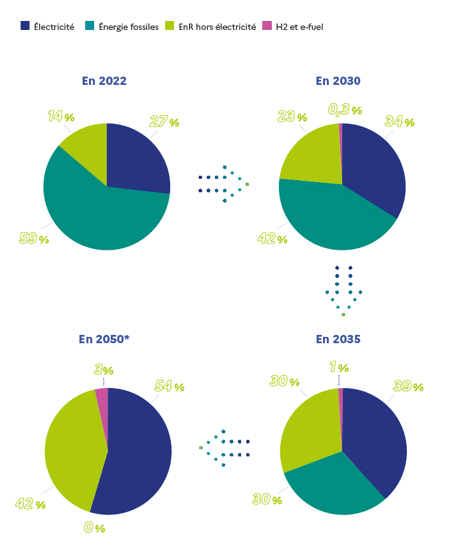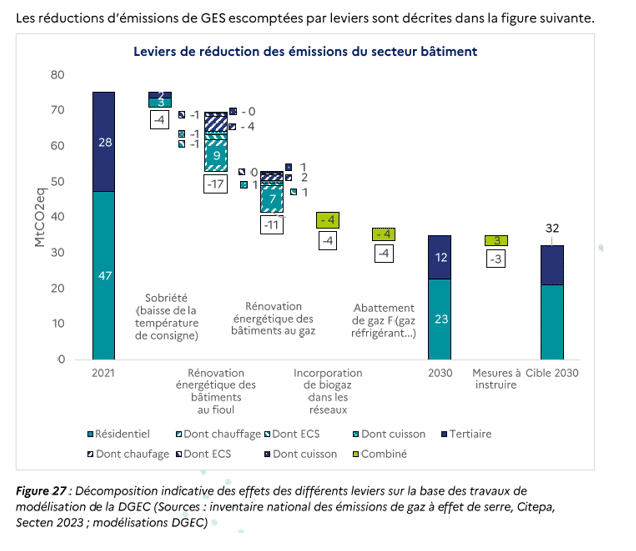What should we remember from the new energy and climate roadmap for the building sector?
Several months late, the government has finally put out for consultation the structuring documents of its roadmap: National Low Carbon Strategy 3 and Multi-year Energy Programming.
What should we remember for the strategic building sector? Sobre Energie gives you its analysis.
France accelerates its emissions reduction target
The SNBC, the French energy and climate roadmap
The National Low Carbon Strategy (SNBC) dates from the 2015 law and constitutes France's framework for action in terms of climate change mitigation. The law provides for its review every five years.
SNBC 2, still in force, was adopted by decree in April 2020. Since 2021, the Government has undertaken numerous works to implement the third edition of the SNBC.
The SNBC includes:
• a long-term objective, carbon neutrality in 2050 and the reduction of the carbon footprint of the French
• a robust scenario for reducing Greenhouse Gas (GHG) emissions in all sectors of activity, capable of guiding collective action to achieve our climate objectives. This scenario takes into account all physical, social, economic and environmental constraints
• greenhouse gas emissions ceilings not to be exceeded over periods of 5 years, known as carbon budgets.
Last year, in 2023, GHG emissions decreased by 5.8% compared to 2022. For structural reasons, but also cyclical (rising energy prices encouraging sobriety, milder winter, etc.)
Objectives raised in SNBC 3
SNBC 3 raises France's objectives by aligning with those of the European Union (“Fit for 55” legislative package providing for reducing EU emissions by 55% in 2030 vs. 1990).
Thus, the new objective for reducing greenhouse gas emissions is to reduce gross emissions by 50% by 2030 compared to 1990; it was 40% in SNBC 2.
To achieve this territorial objective, we must reduce our emissions by 5% each year between 2022 and 2030, compared to an annual reduction of 2% on average from 2017 to 2022.

All sectors of activity will be concerned, but more particularly that of construction. It has already reduced its emissions by a third since 1990 (2nd after industry in terms of the effort made) but the SNBC 3 plans the greatest effort (still -50% by 2030), an effort increased compared to at SNBC 2.

To reduce GHG emissions in both the building and transport sectors (1/3 of French emissions), the electrification of vehicles is an important lever for action.
Consume less and better in our tertiary buildings
Multi-annual energy programming
Created by the law of August 17, 2015 relating to the energy transition for green growth, the Multi-Annual Energy Program (PPE) is a tool for steering France's energy policy. It sets priorities for action
for energy policy which will allow France to achieve carbon neutrality in 2050, a necessity to respond to the climate challenge.
Each PPE covers two successive periods of five years. This third PPE is established for the period 2025-2035. Like the previous ones, it will be reviewed mid-term, in 2030.
PPE 3 in consultation
This 3rd PPE, currently subject to consultation, plans to significantly decarbonize our economy: going from 60% fossil fuels in our energy mix in 2022 to 0% by 2050.

Levers of action in the construction sector
- Sustaining sobriety
Emissions from the building sector represent 16% of France's gross emissions, 2/3 for residential buildings, 1/3 for the tertiary sector.
France's energy and climate roadmap provides for a "strong reduction in consumption through sobriety and renovation" to "consolidate over time the 10% drop in gas & electricity consumption in 2022 vs 2019".
This will result in compliance with the objectives of the Tertiary Decree which plans to reduce the energy consumption of subject sites by 40% in 2030, by 50% in 2040 and 60% by 2050.
The roadmap also provides strong objectives to decarbonize the use of heating:
• the end of the use of fuel oil (objective = 1% of tertiary areas in 2030)
• the replacement of 20% of gas boilers by 2030
These heating methods are replaced by carbon-free devices such as heat pumps. Geothermal heat pumps, which are more energy efficient, will be favored where possible. The development of heat networks will also contribute to the objectives of decarbonization of the heating method
3. Respect the BACS decree
Compliance with the BACS decree, relating to temperature regulation systems for heating and cooling systems, in buildings with a nominal useful power greater than 70kW by 2027, will allow, thanks to GTB (Technical Building Management) to accelerate energy savings.
A light BMS model, that is to say non-wired, allows for lower costs to achieve energy savings of between 20 and 30%

Towards new regulations for tertiary buildings
As it stands, the current policies already in force (Tertiary Decree, BACS Decree, APER law, etc.) do not make it possible to achieve the objectives of the SNBC 3. New regulatory vehicles are mentioned in the new energy and climate roadmap to speed up.
Upcoming transposition of the European energy efficiency directive
This directive provides for an ambitious objective for public buildings (State, State operators, local authorities) to renovate the stock of 3%/year at the “near zero emissions building” (NZEB) level, allowing the public sector to set an example. . Renovations which could concern, for example, school buildings that are often old and energy-intensive. For this type of building, the EduRénov program of the Banque des Territoires, of which Sobre Energie is a partner, makes it possible to finance audits and then work on schools, middle schools and high schools.
Future transposition of the new energy performance of buildings directive
This European directive, adopted last April, provides "that by May 2026 at the latest, member states will establish a system of renovation passports" comprising several elements:
• The level of current energy performance
• Energy performance actions (APE) to reduce the level of consumption
• Estimates of energy gains and reduction of GHG emissions
• The performance class achieved after implementation of the APEs
• Available funding
